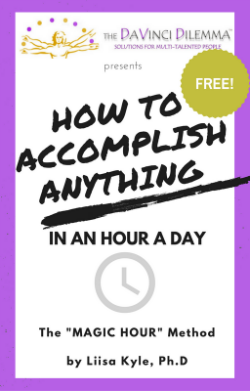 While ordinary people procrastinate over tasks they find unpleasant or tedious, DaVincis often struggle with procrastination due to overwhelm around their own embarrassment of riches — the inability to choose among so many tantalizing options when it comes to pursuing their talents. This kind of either-or paralysis usually disappears once we finally get off the fence about what to do next, perhaps simply by “parking” our other options until later.
While ordinary people procrastinate over tasks they find unpleasant or tedious, DaVincis often struggle with procrastination due to overwhelm around their own embarrassment of riches — the inability to choose among so many tantalizing options when it comes to pursuing their talents. This kind of either-or paralysis usually disappears once we finally get off the fence about what to do next, perhaps simply by “parking” our other options until later.
But many times for us creative types, even once we have committed — or at least think we have — to a goal or creative project, that’s when goofing off, desk re-arranging and all manners of avoidance crop up as irresistible forces. Days and weeks, even months may go by as we ignore the one thing we say we want to do most. This is not mere procrastination. This is Resistance.
The author Steven Pressfield does a masterful job of fleshing out Resistance in his book The War of Art: Break Through the Blocks and Win Your Creative Battles. His description almost makes the problem a living creature with a magnetic personality and a big, fat agenda — to keep you, the creative person, from expressing what’s in your heart and soul. It provides comfort and oh-so-plausible rationalizations for why it’s ok to hit the snooze button half a dozen times and sleep through the period you’d consecrated for your writing. It rears its head most when you are only a few steps from victory. It tells you your time is better spent surfing the internet for more information than getting started and taking action with what you’ve already got. It keeps you stubbornly playing the wallflower in your own life when you know that you were born to dance.
Pressfield says, “Rationalization is Resistance’s right-hand man. Its job is to keep us from feeling the shame we would feel if we truly faced what cowards we are for not doing our work.”
The solution, according to Pressfield? Turn pro. This doesn’t necessarily mean get paid for doing your creative work (though you very well might), it just means, treat it like you would a real job. Pros show up on time, show up no matter what, stay on the job for set hours and are committed over the long haul. No one takes a job and decides they don’t feel like going on Tuesday, or doesn’t show up until lunchtime, or wanders off in the middle of a task. If you’re just dabbling, you leave the door wide open for Resistance walk into your office, pull up a chair and play video Scrabble with you all day.
Turning pro is a shift in both your mindset and your daily practices that invites the Muse to be your ally, rather than the fickle fair-weather friend that is her undeserved reputation. How often have you avoided working on a creative project, only to finally force yourself out of shame, and then discover that it’s not as hard/you’re not as lame as you thought? And then you wonder why you’ve avoided it so long. You can almost hear Resistance howling “D’Oh!” But it doesn’t give up, and tomorrow morning you’ll probably have forgotten your epiphany.
Writer Somerset Maugham, asked if he wrote on a schedule or only when inspired, replied, “I write only when inspiration strikes. Fortunately, it strikes very day at nine o’clock sharp.”
Activity: Here are some tips on how to turn pro and give Resistance the boot (or at least, a run for its money).
Pick a time to start. “Persistent starting” is a trick of Neil Fiore’s from his book The Now Habit. Procrastinators become producers not by trying to finish something but by starting over and over again. Ask yourself when you can start.
Consider starting at the same time each day. This goes a bit counter to Fiore’s suggestion of just choosing the next time you can start, but it is helpful in “going pro” because you’re treating your project like a job. Routine will help you here and elbow past Resistance on the way to your desk.
Choose a realistic minimum time you will stay “on the job” , write it down and stick to it. A kitchen timer or alarm can help here. Fiore suggests you begin with 30 minutes of quality work before your give yourself “credit”. You can build on this as your schedule allows and as you build your discipline muscle.
Before you “punch out,” decide where you will start next. This is a trick Hemingway often used; he forced himself to leave off his writing at a point where he really wanted to continue and knew what he would write next. This helped him get his next writing session jump-started (and after that previous night he probably needed all the help he could get). This practice gives you an automatic end-run around that “stuck” feeling Resistance loves. Once you’re working, Resistance has lost.
Collect your “salary” – reward yourself with hearty self-praise or a fun break when you have finished your work for the day. You deserve it!
Where could you “go pro” and foil Resistance? Or have you already made that commitment? Tell us what’s worked for you.
*****
If you’d like to share or publish this article, you may, if you include the author’s name, a link to this original post and the following text blurb:
Are you struggling with too many talents, skills, ideas? You may have The Da Vinci Dilemma™! Find tools, fun quizzes, coaching, inspiration and solutions for multi-talented people at http://www.davincidilemma.com/.



